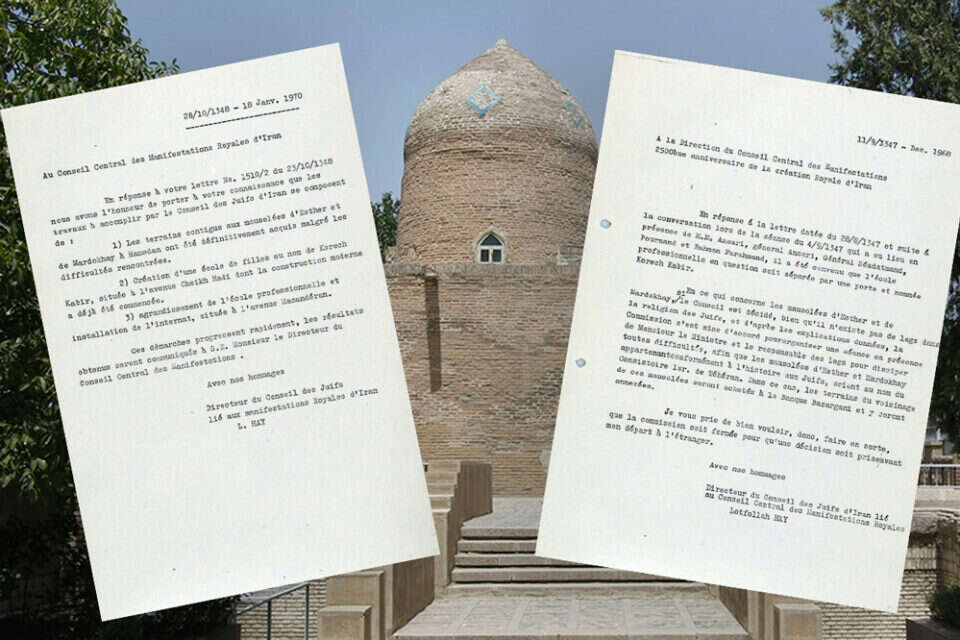An exchange of historical letters from 1968, which reveals the National Library ahead of Purim, proves that representatives of Iranian Jewry purchased the tomb of Mordechai and Esther in the city of Madan, a city in western Iran, in celebration of the 2,500th anniversary of the Cyrus Declaration, cited in 1971.
The letters revealed the negotiations between the Jewish representatives in the country and the Shah's authorities, with the aim of purchasing the plot of land, where, according to tradition, Mordechai the Jew and Queen Esther are buried.
The subject of the tomb of Mordechai and Esther is a controversial one because their burial place is not described in the Jewish sources.
According to some medieval traditions, the burial place is in Hamdan.
One of the traditions associated with the tomb tells that after the death of King Ahasuerus, Haman's supporters sought revenge on Esther and Mordecai.
The two fled to Hamdan and died there.
The first evidence of the mausoleum's association with Esther and Mordechai was provided by Benjamin of Tudela, a 12th-century wandering Jew.
This is what the explorer of the lands writes: "And from that mountain to the greedy one walks for ten days, it is the uniform of the great city, and there like fifty thousand from Israel and there before one Knesset Mordechai and Esther are buried."
The first letter in 1968, Photo: National Library
The extraordinary correspondence has been preserved in the archives of the ORT organization, which is kept in the Central Archives of the History of the Jewish People in the National Library, and according to the library's curator of Islam, Dr. Sam Troop, it testifies that Iran's last Shah - Muhammad Reza This is to the Jews of the kingdom.The celebrations of the 2,500th anniversary of the declaration of Cyrus were exactly his event the Shah expected.
The government demanded an answer
In a letter sent by the director general of the Department of Archeology and Public Education, Abdulli Formand, to Iran's Jewish representative in parliament, to Tafallah Hai, the first clarifies that the Ministry of National Education will assist the Jewish community in Iran to purchase the tomb and lands around it from Bazargani Bank. Entrance tickets to the tomb.
In the correspondence between the ministry and the representative of the Jews, the regime's sense of urgency is felt.
The sender, Formand Frehman, urges the Jewish community to return an answer to the initiative, as the ministry's inquiries have not yet been answered.
According to the letters, the tomb lands were indeed purchased and the transaction was made on January 18, 1970, after which the plot of land was transferred to the Jewish community.
Dr. Trop: "The correspondence indicates that the Shah saw himself as Cyrus' successor and sought to project this image to the Jews of the kingdom.
The festivities were exactly what he expected. "
Despite the historic achievement, the "honeymoon" of Iranian Jews and the country's authorities came to an end fairly quickly with Khomeini's rise to power and the establishment of the Islamic Revolution in Iran in 1979. At the same time, Iran's last Shah fled to the United States.
It should be noted that despite the long tradition that identifies the tomb with the figures of Mordechai and Esther, the entire story of the scroll is not documented in Iranian scriptures, and is, according to one of the leading explanations, the tomb of Queen Shushan-Dachat, the wife of King Yazdegard I in the 5th-4th century CE.
Dr. Sam Troop, curator of the Islam Collection at the National Library, explains that "this story sheds a unique light on the Jewish community's ties with the Iranian authorities over the years and the special status of Cyrus, both among Jews and the Persian public."
Were we wrong?
Fixed!
If you found an error in the article, we'll be happy for you to share it with us

